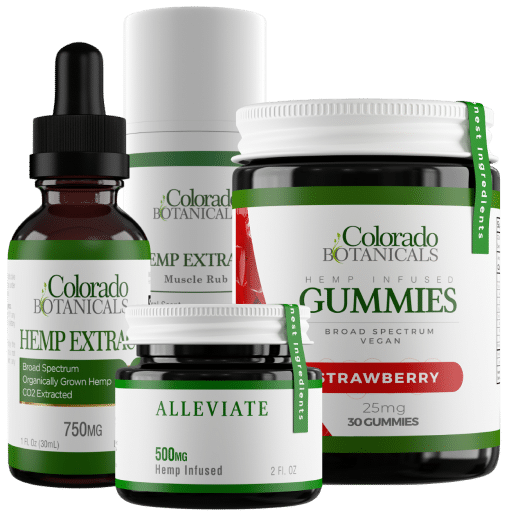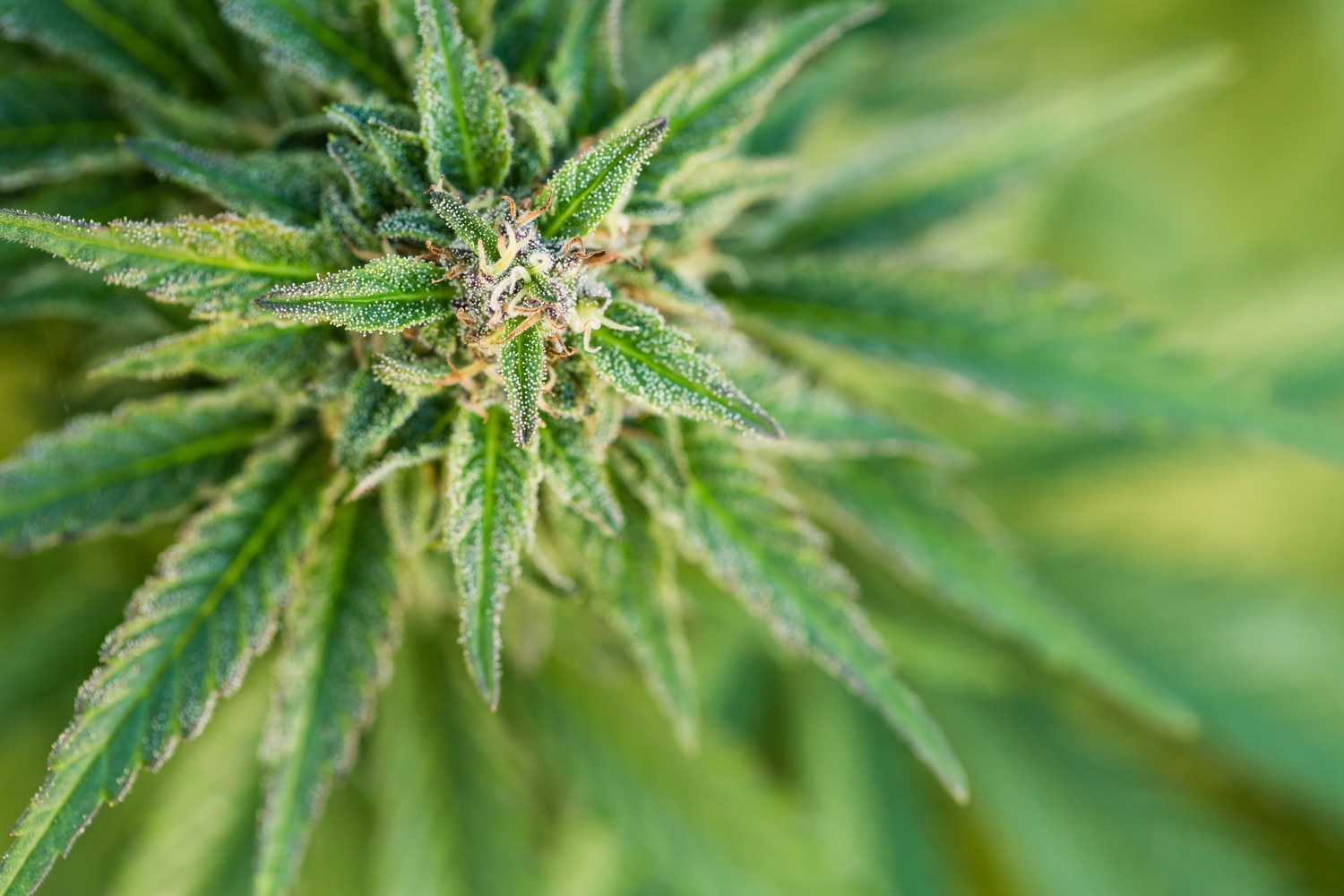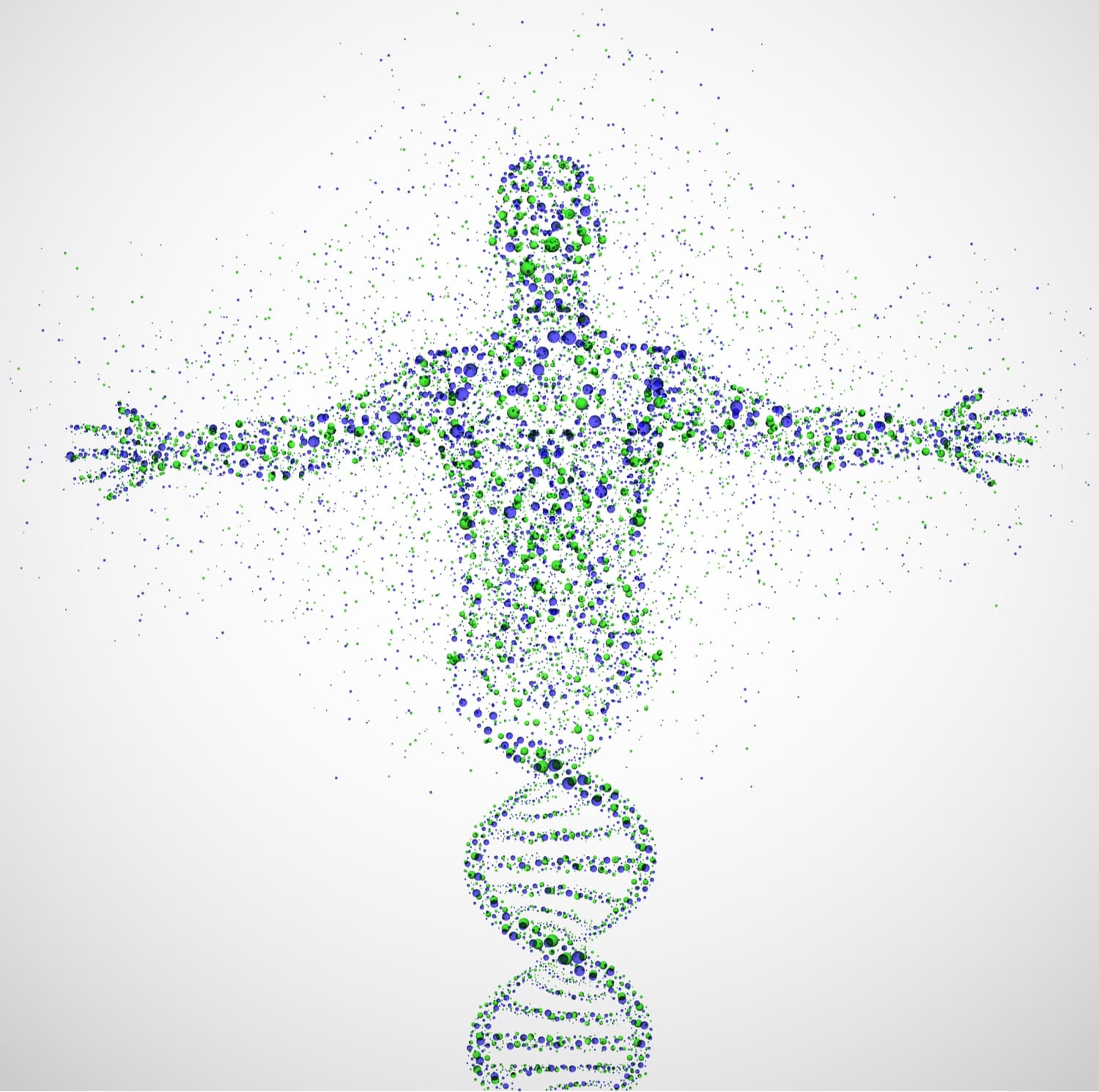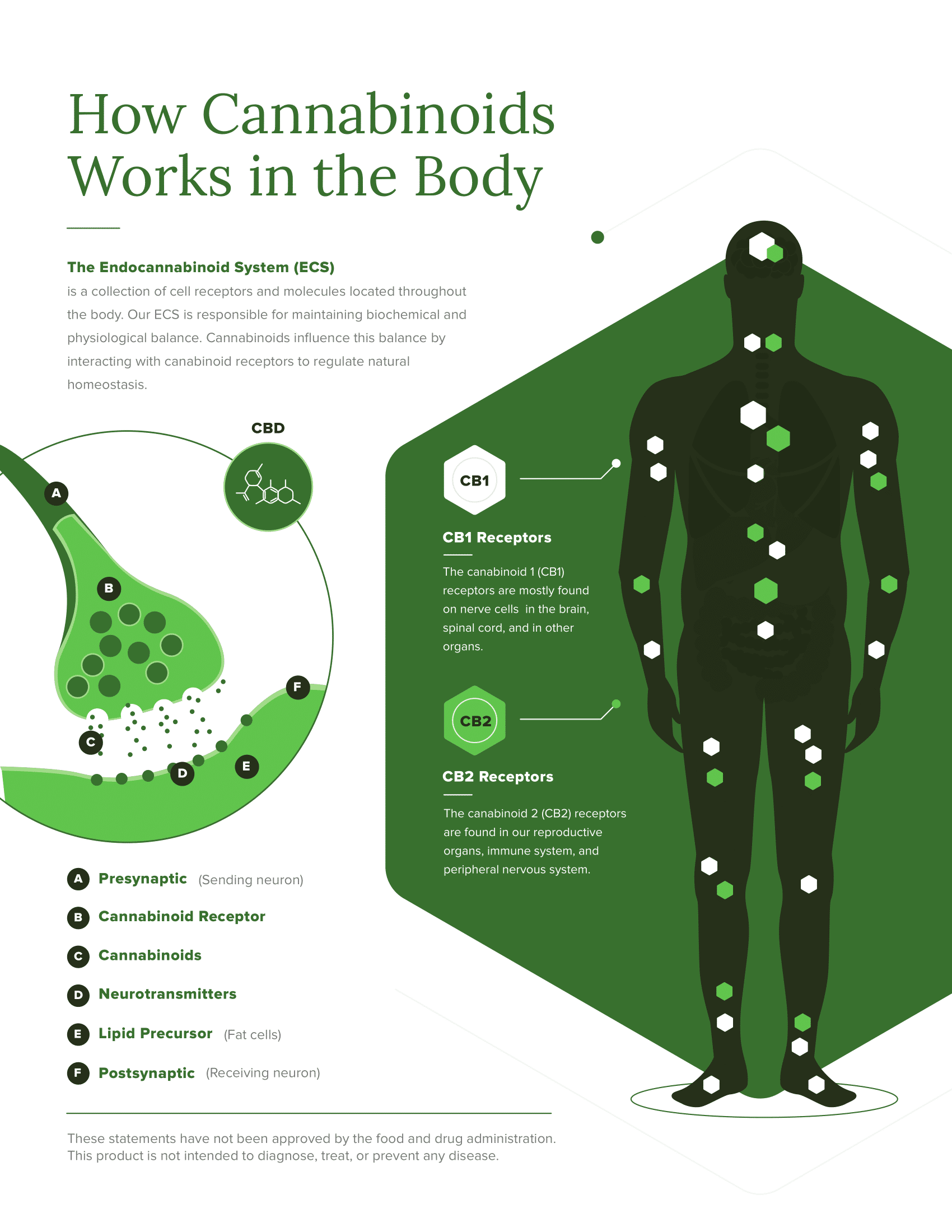
Imagine a drug that has been used medicinally for over 8,000 years.
Medicine of choice in the early 1900s used to help with sleeping, pain, inflammation, and seizures.
Today, that drug is recognized by researchers for its ability to control seizures, suppress cancer growth in cell cultures, slow the progression of Alzheimer’s disease, and provide protection to the brain after a stroke.
A drug like this could be considered a medical miracle, right? It may come as no surprise that this “miracle drug” is in fact cannabis.
For decades, marijuana research has to lead the way for new initiatives in the areas of human biology, health, and diseases, and in the 1990s something wonderful happened. The Endocannabinoid System was discovered and with it the realization that it is a crucial molecular system that helps the human body function.
However, it isn’t something that happened overnight.
- Cannabidiol, the non-psychoactive cannabinoid in cannabis, was discovered by researchers in 1894, and it was the first plant-derived cannabinoid discovered.
- In 1930 researchers were able to discover the structure of cannabidiol.
- In 1940 Cannabidiol (CBD) was discovered.
- In 1943 the structure of CBD was discovered.
- Science was changed in 1964 when THC (the psychoactive component of cannabis) was discovered and isolated.
- 1988 led to the discovery of cannabinoid receptors in an animal’s brain.
- 1990 gave us the first cloned cannabinoid receptor.
Research on How CBD Works Led to the Discovery of the Endocannabinoid System
In the 1990’s researchers finally discovered two of the body’s major endocannabinoids, which lead to the discovery of the endocannabinoid system. This discovery has opened the door to understanding how the endocannabinoid system regulates and affects every major part of the body.
What is the Endocannabinoid System?
According to Project CBD, a California-based nonprofit dedicated to promoting and publicizing research in CBD, the endocannabinoid system is a “biochemical communication system in the human body…which plays a crucial role in regulating our physiology, mood, and everyday experience.” This intricate system is comprised of cannabinoid receptors that react to the psychoactive ingredient in marijuana. In other words–we wouldn’t get high or enjoy the medical benefits of marijuana without our endocannabinoid system.
The endocannabinoid system doesn’t just get us high though.
Researchers have determined that the Endocannabinoid System works to regulate processes like:
- Sleep
- Appetite
- Digestion
- Mood
- Motor control
- Immune function
- Reproduction and fertility
- Pleasure and reward
- Memory
- Temperature regulation
- Pain
However, the endocannabinoid system can only regulate these areas when working properly. When this system fails, we see an increase in disease and disorders, like migraines, fibromyalgia, and IBS. Thanks to advances in medical science, we’ve discovered that when the body fails to produce enough of its own endocannabinoids, we may be able to supplement with plant cannabinoids.
What’s the Endocannabinoid System made Of?
Consider it like this, the endocannabinoid receptors are locks, and the cannabinoids (like CBD and THC) are keys. Only certain keys will fit certain locks. The largest endocannabinoid receptors are known as CB1 and CB2, and they affect totally different parts of the body. CB1 is found in the central nervous system, while CB2 is found in the immune system. Though they are both parts of the endocannabinoid system, these receptors respond to different signals and express themselves in completely different ways.
- CB1 is found on nerve cells in the brain and the spinal cord. Though, they can also be found in smaller amounts on the spleen, white blood cells, endocrine glands, and as part of the reproductive, and digestive tracts. Patients suffering from pain, nausea, and depression respond better to medications that affect these receptors, namely ones that include some level of THC.
- CB2 is found on white blood cells, tonsils, the spleen, and in immune cells. Those with Crohn’s disease or irritable bowel syndrome experience more relief from medications that stimulate CB2, in some cases putting patients in full remission.
Unfortunately, every person is different. This means that every person has a different number of receptors in their body, and some can be overexpressed or under-expressed. These same receptors can also respond to a variety of cannabinoids. This complicates the development of therapeutic grade pharmaceuticals for researchers because everyone is going to respond to the medications differently.
How CBD Works in the Human Body
Cannabidiol (CBD) is a non-intoxicating psychoactive cannabinoid that acts as a pleiotropic drug in that it produces many effects through multiple molecular pathways. Pleiotropy refers to the expression of multiple traits by a single gene.
CBD doesn’t directly interact with our two cannabinoid receptors, CB1 and CB2, that many cannabinoids, such as THC or CBG, interact with. Instead, CBD interacts with our endocannabinoids, Endo meaning endogenous or internal and these receptors are considered “endogenous cannabinoids” because cannabinoids interact with them.
The question many people always ask is “how does CBD work in the human body?” We all know it posses many magnificent traits ranging from relieving anxiety to pain and even having anti-cancer properties.

In this section, we’ll go over all the main receptors that CBD interacts with to produce the different medicinal properties we all have seen it do and even some stuff you didn’t know it does such as promoting bone growth.
Anandamide
Anandamide is a molecule within our body named after the Sanskrit word Ananda which means ‘bliss’ or ‘divine happiness.’
It was discovered in 1992 by scientists researching the effects of THC on the brain in the research laboratory of Raphael Mechoulam. Mechoulam is a pioneer in the research of cannabis plant families, including hemp, where you find high concentrations of CBD.
Anandamide functions as a neurotransmitter because it sends messages between nerve cells throughout the nervous system. It mostly affects the brain’s areas that influence pleasure, happiness, cognitive, sensory, and motor functions.
Unlike other receptors, Anandamide is produced on demand rather than sitting in large pools waiting to be released. When CBD is consumed, it increases anandamide production that interacts with receptors in the brain, increasing dopamine levels linked to pleasure and happiness.
Anandamide plays a role in mood regulation, boosting dopamine levels, which increase happiness and joy, reducing pain, managing stress, and regulating sleep, among many other bodily functions.
Ways to increase Anandamide production:
- Exercise
- Chocolates
- CBD
- Black Truffles
- Fruits and vegetables
- Acupuncture
2-arachidonoylglycerol (2-AG)
2-AG, short for 2-arachidonoylglycerol, is the second most widely studied endocannabinoid after anandamide. They also possess many similar properties.
There was an interesting study conducted on 2-AG that was published in The Journal of Sexual Medicine in 2017 by Dr. Sarah Biedermann, MD. In this study, they measured the blood serum levels of anandamide, 2-AG, and cortisol after self-stimulation in both men and women. They found that 2-AG increased during orgasm. However, all other chemicals measured including the “bliss” molecule anandamide, did not change.
2-AG and anandamide are similar in that they are released from the postsynaptic neuron that is receiving the neurotransmitter back across the synapse to interact with the presynaptic neuron sending it.
Sending messages back to the presynaptic neuron that is sending messages allows for many physiological functions to occur. Such as simply telling the presynaptic neuron to stop firing to inducing neuroplastic changes that neural junction.
Something else that is interesting is that 2-AG and anandamide both attach to the CB1 receptor but anandamide, however, anandamide doesn’t attach to the CB2 receptor while 2-AG is a full CB2 agonist, meaning that it’s capable of producing a maximum response.
If you recall from reading about the Endocannabinoid System, CB1 receptors are found mainly in the Peripheral Nervous System (PNS), which consists of the brain and spinal cord. In comparison, the CB2 receptors are found in our Central Nervous System (CNS), which consists of our immune system and inflammation response.
TRPV1
TRPV1, is one of the dozen TRP (pronounced “trip”) receptor subfamilies that mediate a wide range of therapeutic benefits.
It’s also called the “capsaicin receptor” since it’s the primary receptor that capsaicin, an anti-inflammatory compound found in chili peppers, binds to when it enters the body.
TRPV1, also called vanilloid receptor 1, helps control our body temperature and plays a role in how we feel pain. Several methods can activate this receptor:
- Temperatures above 109 degrees Fahrenheit
- Capsaicin, a molecule responsible for the spicy sensation of chili peppers
- Acidic conditions in the body
- Anandamide
- Cannabidiol (CBD)
The primary function of TRPV1 is to cause searing pain, but prolonged TRPV1 activation reduces pain. It does so by “desensitization” of the receptors, which is achieved by prolonged exposure to activating agents.
CBD as an Allosteric Modulator
CBD has shown to have a unique trait of reducing the intoxicating effects caused by THC. It’s capable of doing this because CBD is an al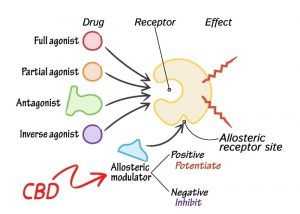 losteric receptor modulator. This means that it can either enhance or inhibit how a receptor transmits a signal by changing the shape of the receptor. CBD can either be a negative allosteric receptor modulator or positive, which we’ll cover.
losteric receptor modulator. This means that it can either enhance or inhibit how a receptor transmits a signal by changing the shape of the receptor. CBD can either be a negative allosteric receptor modulator or positive, which we’ll cover.
CBD is known to act as a negative allosteric receptor modulator to the cannabinoid receptor CB1 found in our Central Nervous System, which is mainly in our brain and spinal cord. The same cannabinoid receptor that THC attaches to produce its intoxicating effects when consumed.
While CBD doesn’t attach directly to the CB1 receptor, studies show that it acts in a negative allosteric method where it changes the shape of the CB1 receptor in a way that weakens CB1’s ability to bind with THC. This explains CBD’s ability to inhibit the intoxicating effects caused by THC. People don’t feel as “high” when consuming CBD-rich cannabis or consuming a THC product along with CBD.
CBD and the GPR55 Receptor
CBD is a GPR55 antagonist, meaning it achieves its effects by blocking GPR55 signaling. This receptor is crucial, as it’s responsible for a variety of functions, which we’ll cover in a second.
According to a 2017 review in the Journal of Molecular Endocrinology, the GPR55 is a new type of endocannabinoid receptor. First discovered in 1999, it exists in both the central and peripheral areas of the body. But it wasn’t until 2007 that we fully understood its connection with the ECS.
A 2016 publication in Current Medical Chemistry explains the many roles of GPR55 receptors, including:
- Inflammation
- Bone health
- Cancer
- Diabetes
- Neuropathic pain
Coincidentally, plenty of preliminary and anecdotal evidence support’s CBD’s therapeutic or preventative benefits in the above areas.
CBD and the PPARS Receptor
The PPARs are another critical multi-role receptor that interacts with CBD. Unlike GPR55, however, CBD is an agonist, not an antagonist. In other words, it triggers – rather than suppresses – the PPARS receptors.
A 2011 review in the Journal of Advanced Pharmaceutical Technology and Research explored the potential benefits of PPARs agonists in areas like:
- Diabetes
- Glucose metabolism
- Energy balance
- Cancer
- Inflammation
- Neurodegenerative disorders
- Pain
- Obesity
The study found promising evidence that PPARs agonists (such as CBD) may help improve, control, or prevent a variety of symptoms and conditions. Most notably such cannabinoids show promise for cancer and Alzheimer’s patients.

CBD as a Reuptake Inhibitor
CBD’s role as a reuptake inhibitor has huge implications for its potential medicinal properties. Matt Elmes, the director of new product development at Cannacraft gave his expert insight during a 2019 interview.
According to Elmes, cannabinoids like THC and CBD can’t just walk into a cell’s nucleus. They – like endocannabinoids – need to be transported on FABPs (fatty acid-binding proteins).
To put it another way, imagine cannabinoids sneaking into cells like a microscopic Trojan Horse (FABPs being the horse). Once inside, CBD goes to work distributing its effects to places like the nearby PPARS receptors we mentioned earlier.
But there’s a catch. As Elmes explains: “THC and CBD can compete for anandamide uptake.” In other words, CBD and other cannabinoid “passengers” don’t get along.
With CBD on the FABPs, there’s less room for anandamide. Consequently, a large portion of the endocannabinoid gets left behind.
But is this a bad thing? According to Elmes, it’s quite the opposite. Less anandamide in the cell means more stays behind. Elmes explains:
So, if we block that transport step, there’s going to be less anandamide broken down, and hence more anandamide in your body that’s able to signal and hit cannabinoid receptors.
Ultimately, the process improves endocannabinoid receptor signaling. Suddenly, the ECS starts working extra hard to more successfully maintain homeostasis.
Conclusion
The endocannabinoid system is a complex network of receptors that signal the body to maintain a state of functional balance called “homeostasis.”. Our ECS allows us to enjoy the benefits of endocannabinoids and phytocannabinoids (like CBD) for therapeutic or recreational purposes.
Although many cannabinoids directly bind to the CB1 or CB2 receptors, CBD does neither. Instead, it affects other receptors such as GPR55 and PPARs while altering the endocannabinoid receptors.
These interactions and alterations change the way we absorb certain cannabinoids or prevent their effects altogether. Meanwhile, CBD’s effects on non-ECS receptors help provide a range of potential therapeutic benefits.
Despite an information gap, growing research improves our understanding of CBD and often supports many medical claims. It’s pretty likely we’ll see more thorough studies soon.



